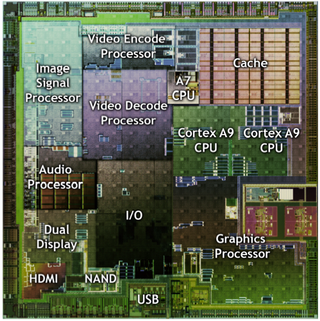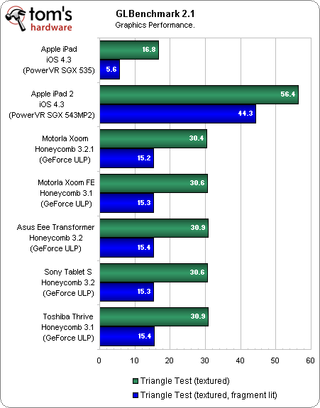Sony Tablet S Review: The Media Enthusiast's Dream Tablet
Graphics Performance: Tegra 2
As we’ve mentioned in the past, mobile devices like smartphones and tablets use highly integrated logic referred to as SoCs to minimize physical footprints and power consumption, all the while optimizing for performance and functionality. By putting execution resource, graphics processing, system memory, and several other subsystems in a single ASIC, data transfers can be achieved more efficiently without soldering a bunch of separate chips onto a PCB. Incidentally, the same SoC term applies to modern desktop processors like Intel's Sandy Bridge- and AMD's Bulldozer-based chips, which combine cores, cache, memory controllers, and other capabilities.
| SoC | Apple A4 (iPad) | Apple A5 | Nvidia Tegra 2 |
|---|---|---|---|
| Tablets | Apple iPad | Apple iPad 2 | Acer Iconia Tab A500Asus Eee Pad TransformerMotorola XoomMotorola Xoom Family EditionSamsung Galaxy Tab 10.1Sony Tablet SToshiba Thrive |
| Processor | 1 GHz ARM Cortex-A8 (single-core) | 1 GHz ARM Cortex-A9 (dual-core) | 1 GHz ARM Cortex-A9 (dual-core) |
| Memory | 256 MB 333 MHz LP-DDR (single-channel) | 512 MB 1066 MHz LP-DDR2 (dual-channel) | 1 GB 667 MHz LP-DDR2 (single-channel) |
| Graphics | PowerVR SGX535 (single-core) | PowerVR SGX545MP2 (dual-core) | ULP GeForce (single-core) |
| L1 Cache(Instruction/Data) | 32 KB / 32 KB | 32 KB / 32 KB | 32 KB / 32 KB |
| L2 Cache | 640 KB | 1 MB | 1 MB |
Tegra is Nvidia’s SoC brand, and it represents the company’s effort to tap into the mobile market beyond its desktop-derived GeForce graphics processors. For those unfamiliar with Tegra 2, read page eight of our Motorola Xoom review for a full discussion of GPU architecture. On the CPU side, Tegra 2 shares the same dual-core Cortex-A9, which offers a substantial boost from Cortex-A8 used in the first-generation iPad. Read Apple's iPad 2 Review: Tom's Goes Down The Tablet Rabbit Hole for a full discussion of Cortex-A9 performance.

While we've already covered Tegra 2, it's important to examine the graphics performance of each tablet. Sy Choudhury, director of product management at Qualcomm, once stated, "There is a misconception that the same processor and operating system gives the same performance." Why is it wrong to expect the same performance from all Android-based Tegra 2 tablets? Hardware vendors get access to the same optimizations from the SoC developer, but not all of the software-based tweaks are enabled by OEMs.
| GPU (System-on-Chip) | PowerVR SGX 535 (Apple A4) | PowerVR SGX 543 (Apple A5) | ULP GeForce (Tegra 2) |
|---|---|---|---|
| SIMD | USSE | USSE2 | Core |
| Pipelines | 2 (unified) | 4 (unified) | 8 (4 pixel / 4 vertex) |
| TMUs | 2 | 2 | 2 |
| Bus Width (bit) | 64 | 64 | 32 |
| Triangle rate @ 200 MHz | 14 MTriangles/s | 35 MTriangles/s | ? |
The ULP GeForce has a maximum operating frequency of 300 MHz, but device vendors can tweak this setting to save on power. Nvidia provides less information on the Tegra 2 than it does for its desktop GPUs, so it’s best to move on to benchmarks. As in our iPad 2 review, we're turning to GLBenchmark. However, since the publisher of this benchmark recently released version 2.1, our scores are different from what you've seen in the past.

The Tablet S offers performance typical of a Tegra 2-based tablet. It's better than the iPad, but worse than the iPad 2. However, the standard Egypt and Pro tests only measure performance at a tablet's native resolution. On Android-based tablets, this is always 1280x800 (compared to the iPad/iPad 2's 1024x768).

GLBenchmark 2.1 introduces a new off-screen test, which standardizes performance to 720p. Based on the new tests, we see a smaller gap between the Tegra 2 and PowerVR SGX543MP2, but the latter still outperforms the former by ~50%. As a result, it's not surprising to hear that Sony will employ a quad-core PowerVR SGX 543MP2 on its PlayStation Vita, the PSP's successor.

Stay on the Cutting Edge
Join the experts who read Tom's Hardware for the inside track on enthusiast PC tech news — and have for over 25 years. We'll send breaking news and in-depth reviews of CPUs, GPUs, AI, maker hardware and more straight to your inbox.
Current page: Graphics Performance: Tegra 2
Prev Page PlayStation Store: Unimpressive Tablet Games Next Page Display Quality: Color GamutMost Popular

